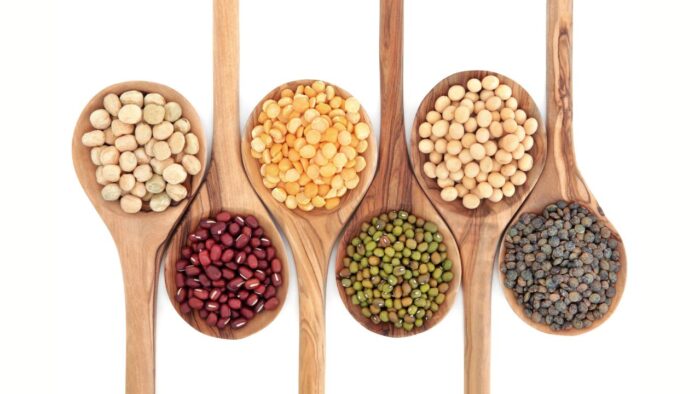Ask most any chef, Indian cook or food expert, and they will pause before clearly describing terms related to the best plant proteins in the world.

The ancient texts of ayurveda, arguably the oldest wisdom on food shared without interruption down into the modern day, advise repeatedly that the dhānya (plants of greatest value) food groups are the most nourishing for our bodies. Dhānya were edible seeds that were used as currency and trade in ancient times. Śūka dhānyā are the cereals grasses of which śāli dhānyā are rice varieties, tṛṇa dhānyā are millets, and godhūma is ancient, non-separated wheat. Śimbi-dhānyās are the pulses, the dried seeds of various grasses and vines that have pods containing large seeds that are collected and edible.
Legumes are an umbrella term for any plant that creates its fruit or seed inside a plant with pods. Pods are a fibrous case that splits along both sides when ripe, having seeds attached to one side of the case. Legumes include various beans, peas, lentils and peanuts.
Beans are large seeds that exist in pods and are a subset of the legume family. Sometimes they grow in plants, and sometimes they are vines, or trees or shrubs. In modern science, beans are organized by the botanical family name Fabaceae, also known as Leguminosae. The plants can be grasses, vines, trees or small plants. The ancient Fertile Crescent of central Eurasia is the native home to lentils, broad beans, peas, and chickpeas. Soybeans, adzuki beans and mung beans are indigenous to Asia. Peanuts, lima beans, black turtle beans, pinto beans, navy (white beans served to US Navy sailors) beans, and green beans are native to the Americas. Black-eyed peas are a type of cowpea with a green-yellow color and a black spot near the ridge that are native to Africa. Other types of beans include kidney beans (which can be white, red, maroon or speckled) and the broad bean also known as fava bean.
The pea is sometimes called a member of the bean family because it also grows in pods. It is a small, round green edible seed that grows with other seeds together inside a long thin pod on a climbing plant that bears flowers. However the seeds of peas contain different roots, leaves and internal sprouting structures than the seeds of beans, that correspond with the way nutrients are stored. They are considered different from beans by the botanical scientists due to their embryonic leaves called cotyledons. When these round globular peas are split in half, they are called split peas.
Lentils are the whole or split bean of a lens-shaped seed that comes from a pod. Usually each pod has two seeds, each of which have the shape of a lens. The seed can either have a skin on its surface or not. Lens culinaris is the main botanical species that inspired the term lentil. Lentils are often sold with their hulls removed ("shelled") and are then known as daal. They are classified according to their size, whether they have their shell or not, and whether they are split or whole. Canada then India are the largest producers of lentils.
Pulses are the dried seeds of edible beans and lentils that can be split easily in half. When they are raw and have moisture, they are called beans and peas. When they are dried, they are then called pulses, and are more portable, able to be stored, traded and used up to a year later and included over 1800 species. When prepared as food, they are used to make thick soups.
Dahl is the term for both the thick edible soup and the seed of the lentil, pea, or legume that has been dried, hulled, and split. Once it is split, it is ready to be made into edible preparations. Beans that have not been split are not dahl. Beans that are not dried are not dahls.
Gram are a type of round bean seed with an irregular texture and cover, with a notch on one end and a curved ridge on the other that looks like a chick's head. Various grams exist such as the large chickpea also known as garbanzo, the horse gram known as kulattha, and the bengal gram, which is the split chickpea without its skin, also known as chana dal. When dried, gram are part of the pulses that can be used as food.
When they are cooked, most legumes yield a grainy thick soft texture that can be made into a paste and then watered down to a gravy or soup.
The cultivation, harvesting, drying, storing and processing of these seeds determines its medicinal properties. A dried bean ("pulse") that is toasted on dry heat becomes harder to digest for humans. The same bean can be soaked in water then boiled, or immediately boiled, or steamed, sauted in ghee, fried in oil, or mixed with other beans. Each choice changes the medicinal property of the bean. One reason to follow traditional ayurvedic recipes is that they inform us which steps will yield which medicinal outcomes.
*****************





